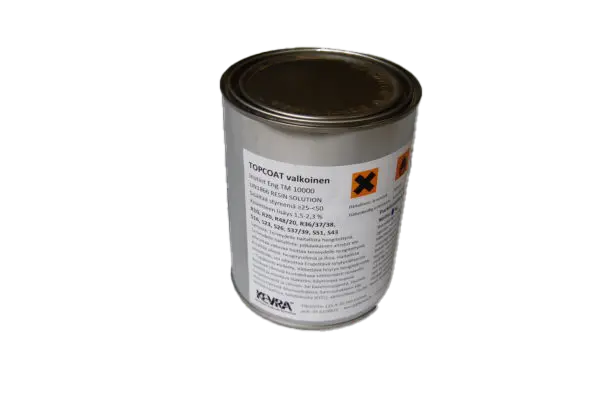Product description
TOPCOAT GREY 1 KG
Topcoat is a paraffin-based surface coating (gelcoat + wax) that is cured with MEK hardener. Unlike gelcoat, it cures in contact with air. It is used for coating and repairing fiber-reinforced plastic components.
Topcoat requires 1–2% MEK-50 hardener (methyl ethyl ketone peroxide).
1 kg of resin component requires 10–20 g Hardener MEK-50
Working process
Before painting, the surface of the laminate must be thoroughly cleaned of any release agent residues, dirt, and grease. After that, the surface is sanded with 180–220 grit sandpaper. If there are any irregularities or surface damages, they should be repaired before painting. Below is a link to the repair instructions.
Topcoat should be applied in two coats to achieve proper water resistance. It should be applied as soon as possible after the laminate is made. The maximum interval without sanding is 6 hours. If the application is done later, the laminate surface must be sanded and thoroughly cleaned before painting. This ensures good adhesion of the topcoat. Consumption is approx. 600 g/m².
Gel time with 1.5% hardener (20 °C): 10–25 min
Since topcoat is not self-leveling, it must be applied in sufficient thickness (2–4 layers). This ensures the coating does not break through during wet sanding to achieve a smooth surface. To restore the original surface quality, the grit number of the wet sanding paper should be 1000 or higher.
Topcoat is not used over epoxy resin – the adhesion of polyester-based materials to epoxy is not very good.
The color options available in our selection are white, grey, and black.
Safety
Before handling topcoat, ALWAYS ensure good ventilation and skin protection. Wear a long-sleeved shirt and disposable gloves resistant to topcoat (e.g., nitrile rubber). Uncured epoxy resin is highly sensitizing to the skin.
Flammable liquid and vapor. Causes skin irritation. Causes serious eye irritation. May cause respiratory irritation. Suspected of damaging the unborn child. May cause damage to organs (hearing organs) through prolonged or repeated exposure. Harmful to aquatic life with long-lasting effects.
